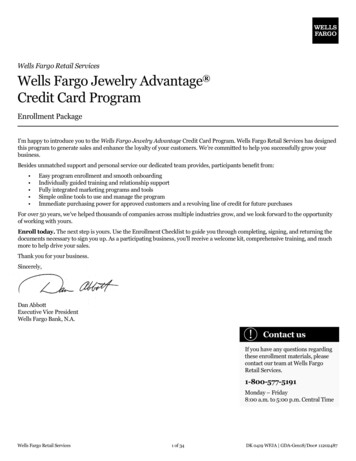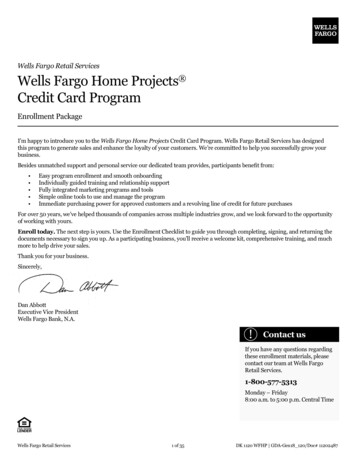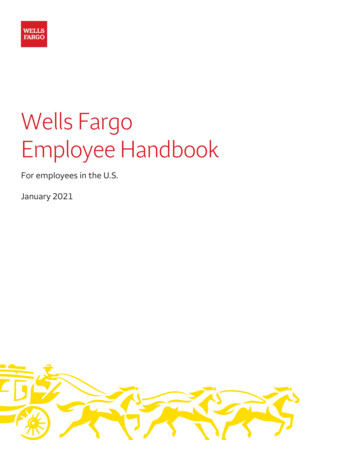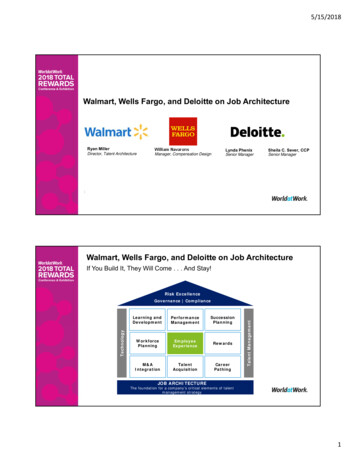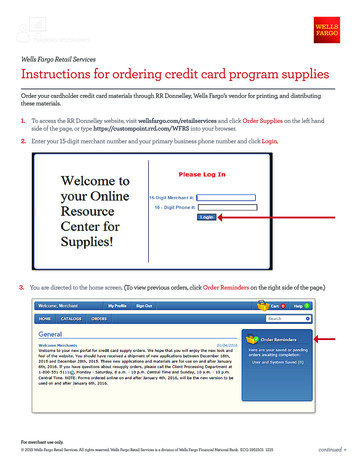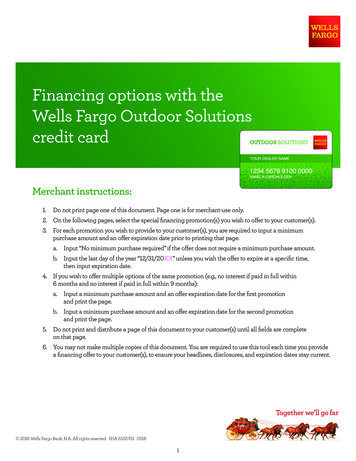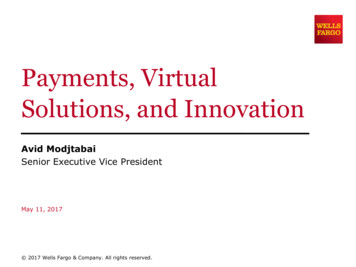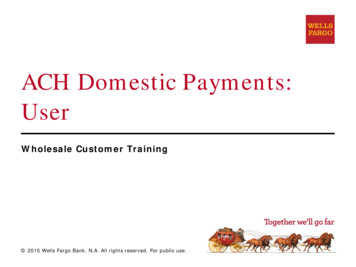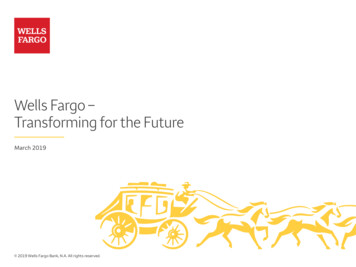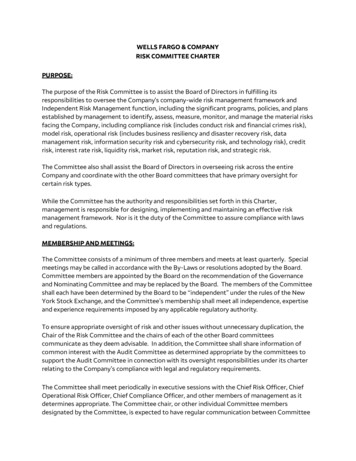
Transcription
WELLS FARGO & COMPANYRISK COMMITTEE CHARTERPURPOSE:The purpose of the Risk Committee is to assist the Board of Directors in fulfilling itsresponsibilities to oversee the Company’s company-wide risk management framework andIndependent Risk Management function, including the significant programs, policies, and plansestablished by management to identify, assess, measure, monitor, and manage the material risksfacing the Company, including compliance risk (includes conduct risk and financial crimes risk),model risk, operational risk (includes business resiliency and disaster recovery risk, datamanagement risk, information security risk and cybersecurity risk, and technology risk), creditrisk, interest rate risk, liquidity risk, market risk, reputation risk, and strategic risk.The Committee also shall assist the Board of Directors in overseeing risk across the entireCompany and coordinate with the other Board committees that have primary oversight forcertain risk types.While the Committee has the authority and responsibilities set forth in this Charter,management is responsible for designing, implementing and maintaining an effective riskmanagement framework. Nor is it the duty of the Committee to assure compliance with lawsand regulations.MEMBERSHIP AND MEETINGS:The Committee consists of a minimum of three members and meets at least quarterly. Specialmeetings may be called in accordance with the By-Laws or resolutions adopted by the Board.Committee members are appointed by the Board on the recommendation of the Governanceand Nominating Committee and may be replaced by the Board. The members of the Committeeshall each have been determined by the Board to be “independent” under the rules of the NewYork Stock Exchange, and the Committee’s membership shall meet all independence, expertiseand experience requirements imposed by any applicable regulatory authority.To ensure appropriate oversight of risk and other issues without unnecessary duplication, theChair of the Risk Committee and the chairs of each of the other Board committeescommunicate as they deem advisable. In addition, the Committee shall share information ofcommon interest with the Audit Committee as determined appropriate by the committees tosupport the Audit Committee in connection with its oversight responsibilities under its charterrelating to the Company’s compliance with legal and regulatory requirements.The Committee shall meet periodically in executive sessions with the Chief Risk Officer, ChiefOperational Risk Officer, Chief Compliance Officer, and other members of management as itdetermines appropriate. The Committee chair, or other individual Committee membersdesignated by the Committee, is expected to have regular communication between Committee
meetings with the Chief Risk Officer and, as needed, other members of management. The ChiefRisk Officer and, as needed, other members of management are expected to communicate withthe Chair on any significant risk issues that arise between Committee meetings, including issuesraised or escalated by management’s Enterprise Risk & Control Committee. In addition, each ofthe members of the Board’s other committees is expected to bring to the attention of his or hercommittee Chair, or the Chief Risk Officer, any risk issues that such committee member believesshould be discussed by the Committee.AUTHORITY AND RESPONSIBILITIES:1.Risk Management Framework. The Committee shall oversee the Company’s riskmanagement framework, including the Company’s risk management program,governance structures used by management to execute its risk management program,risk profile, risk appetite, and risk management effectiveness. In connection with itsoversight responsibilities, the Committee shall: Approve and periodically review the Company’s risk management framework andoversee management’s establishment and implementation of the framework,including how the Company supports a strong risk management culture, managesand governs its risk, and defines the risk roles and responsibilities of the Company’sthree lines of defense; Oversee and receive reports from management on the operation of the Company’scompany-wide risk management framework, including policies, procedures,processes, controls, systems, and governance structures for the identification,measurement, assessment, control, mitigation, reporting, and monitoring of risksfacing the Company; Annually review and recommend to the Board for approval the Company’s statementof risk appetite and approve amendments to the Company’s statement of riskappetite, as appropriate. The Committee shall receive reports from managementand, if appropriate, other Board committees, regarding the Company’s adherence toits established risk appetite; Periodically review and, as appropriate or unless otherwise reviewed or approved byanother Board committee with primary oversight of the specific risk type, approvesignificant risk management policies relating to the material risk types identifiedthrough the Company’s enterprise risk identification and assessment program; Review regular reports from the Chief Risk Officer and other members ofmanagement regarding emerging risks, escalated risks or issues, and other selectedcompany-wide risks and issues and/or risk topics; and Review and receive regular reports from the Chief Risk Officer and other members ofmanagement regarding management’s assessment of the effectiveness of the-2-
Company’s risk management program, including risk management effectiveness andactions taken by management to address risk matters and the implementation ofrisk management enhancements.2.Oversight of Independent Risk Management Function. The Committee shall support thestature, authority, and independence of the Independent Risk Management function andappropriate challenge of business decisions. In addition, the Committee shall oversee andreceive reports on the operation of the Independent Risk Management function,financial forecast, staffing levels, and resource needs. The Chief Risk Officer, togetherwith the Independent Risk Management function, shall report functionally to theCommittee and administratively to the Chief Executive Officer. The Committee shallapprove the appointment and replacement of the Chief Risk Officer and annually reviewthe performance of the Chief Risk Officer and approve the Chief Risk Officer’scompensation.3.Oversight of the Company’s Material Financial and Non-Financial Risks. The Committee shall review and, if appropriate, approve significant compliance risk,financial crimes (including Bank Secrecy Act and anti-money laundering) risk, modelrisk, operational risk, information security risk (including cybersecurity risk),technology risk, and data management risk, credit risk, market risk, interest rate risk,and investment risk programs and/or policies, including the Company’s businessresiliency program, compliance program policy, technology and data managementstrategies, financial crimes program, and third party risk management policy.Certain other Board committees have primary oversight of certain risk types,including market risk, interest rate risk, and investment risk. The Committee shall oversee and periodically review and receive updates andreports from management on the state of:–compliance risk and general condition of compliance risk management, includingthe effectiveness of the Company’s compliance program, the annual complianceplan, and the related annual Compliance function staffing plan (including theCompliance financial forecast, staffing, and resource needs);oThe Committee shall approve and oversee the Company’s complianceprogram required under the Volcker Rule and its implementing regulations,including management’s assessment of the effectiveness of the program;–conduct risk, including conduct management activities and Independent RiskManagement’s conduct risk oversight;–financial crimes risk and general condition of financial crimes risk managementand internal controls, including the effectiveness of the Company’s financialcrimes program and suspicious activity monitoring and reporting;-3-
–model risk and the general condition of model risk management, including modelgovernance;–operational risk and general condition of operational risk management, includingthe Company’s operational risk program, operational risk profile, and theeffectiveness of the Company’s operational risk program and controlenvironment;–business resiliency and disaster recovery risk, data management risk, informationsecurity risk (including cybersecurity risk), and technology risk including receivingupdates on the Company’s data management strategy, risk data governance, andcyber defense management program;–credit risk and general condition of credit risk management, including theperformance and quality of the Company’s credit portfolio and credit risk trends;management’s process for establishing the Company’s allowance for creditlosses; the Company’s credit stress testing framework and related stress testresults; and such other credit-related activities as may be required by applicablelaws, rules, or regulations;o4.The Committee shall oversee the organizational structure and resources ofthe Company’s Risk Asset Review (“RAR”) function, receive updates frommanagement relating to the results of RAR’s examinations of the Company’scredit portfolios, processes, and practices and other internal and externalaudits and examinations, and review and approve the Company’s RAR Policyand annual examination plan;–liquidity and funding risks, including quarterly reports on the Company’s liquidityrisk profile, and shall annually review and approve, or recommend to the Boardapproval of, the Company’s liquidity risk management strategies and significantpolicies, which include the Company’s contingency funding plan;–reputation risk, including periodic reporting on reputation risk throughenterprise risk reporting; and–strategic risk, including the alignment of the risk profile and risk managementeffectiveness with the Company’s strategic plan and risk appetite, and risks thatmay be associated with significant new business or strategic initiatives (includingany acquisition activities) as it may deem appropriate.Other Authority; Self-Evaluation; and Charter Review. The Committee shall perform such other duties and responsibilities as may bedirected by the Board or required by applicable laws, rules or regulations.-4-
In performing its responsibilities, the Committee is authorized to obtain advice andassistance from internal or external legal, accounting or other advisors at theCompany’s expense without prior permission of the Board or management. The Committee may, in its discretion, form and delegate all or a portion of itsauthority to subcommittees. The Committee shall document and maintain records of its proceedings, includingrisk management decisions and other approvals, and shall make regular reports tothe Board summarizing the matters reviewed and actions taken at each Committeemeeting. The Committee shall review and assess the adequacy of this Charter annually. TheCommittee may recommend amendments to this Charter at any time and submitamendments for approval to the Board. The Committee shall annually review its own performance.3/1/2021-5-
may be associated with significant new business or strategic initiatives (including any acquisition activities) as it may deem appropriate. 4. Other Authority; Self-Evaluation; and Charter Review. The Committee shall perform such other duties and responsibilities as may be directed by the Bo
